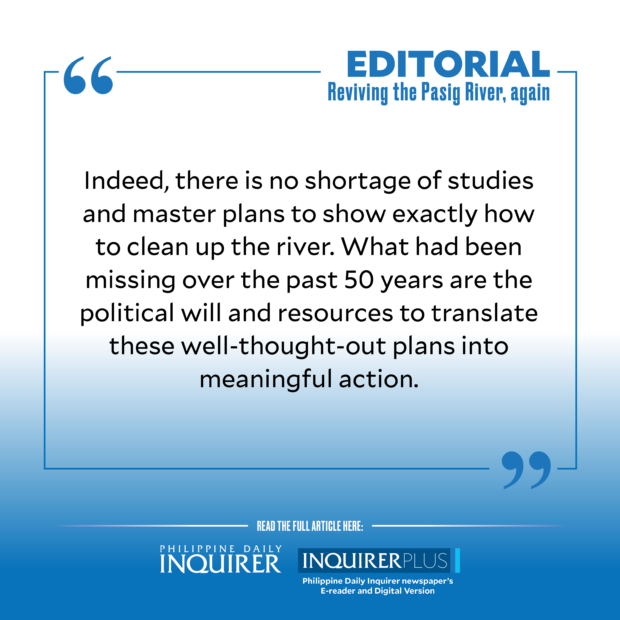Reviving the Pasig River, again
The latest publicity photos of South Korean actor Kim Seon-ho showing him in front of his Bench billboards near the Guadalupe bridge in Makati City went viral on the internet recently—but not exactly because of his good looks and winsome smile.
Stealing the scene from the charming celebrity were the murky, greenish waters of the Pasig River in the background. Netizens were quick to poke fun at Kim, whom they praised for enduring the foul smell and the nasty sight of detritus floating on the river that had been declared “biologically dead” in the 1990s, for being incapable of sustaining marine life.
Article continues after this advertisementThere is nothing funny, however, about the sorry state of the Pasig River that had deteriorated over the years due to the lack of sustained and serious efforts by the government to rehabilitate it and elevate its status from a Class C river.
It is thus with cautious optimism that the public welcomed President Marcos’ Executive Order No. 35 constituting the Inter-Agency Council for the Pasig River Urban Development to be headed by the Department of Human Settlements and Urban Development, and co-chaired by the Metropolitan Manila Development Authority. The council is composed of 15 government agencies to “synchronize and strengthen interagency efforts to accelerate the implementation of policies, programs, and projects that aim to improve the water quality, restore marine life, and develop the banks of Pasig River, its tributaries, and surrounding communities.”
The executive order issued on July 25 acknowledged the 27-kilometer river’s “immense historical and cultural significance, as a vital waterway, which facilitates trade, transportation, and communication, and serves as a prominent landmark and tourist attraction.” Thus, the “urgent need” to rehabilitate it and “enhance the quality of life” along its banks, the executive order stated. A tall order, to say the least, given the numerous failed attempts by previous administrations to similarly clean up the Pasig River often denigrated as Metro Manila’s toilet bowl.
Article continues after this advertisementThe dismal record says it all. As early as 1973, the first Marcos administration formed the Pasig River Development Council to implement the Pasig River Development Program that eventually failed because of lack of follow through. In 1989, the Cory Aquino administration spearheaded the Pasig River Rehabilitation Program aimed at bringing back “ecological health” to the river system. This was followed in 1999 by the creation of the Pasig River Rehabilitation Commission by then President Joseph “Erap” Estrada. It achieved some success in 2018 when the Pasig River was awarded the inaugural Asia Riverprize by the International River Foundation for its efforts to breathe new life into the river by bringing decent housing to some 18,000 people, and transforming this community into environmentally responsible citizens.
Former president Rodrigo Duterte failed to build on that success and instead took a U-turn when he abolished the commission in 2019, dismissing the river as “uncleanable.” All ongoing projects were then transferred to the Manila Bay Task Force.
In April 2021, the Pasig River was given the ignoble title of being the most polluted body of water and leading source of plastic wastes dumped into the ocean, according to a study of rivers worldwide published in Science Advances, a journal of the American Association for the Advancement of Science.
That study noted that of the 20 countries tagged as major contributors of plastic wastes now floating in the world’s oceans, the Philippines was number one. Of the 1,656 rivers found to contribute harmful plastic wastes into the oceans, Pasig River led the pack.
Despite such massive scale of problems hounding Pasig River, the only project of note from the government was the launch in December 2019 of the Pasig River ferry, but even that has failed to attract a critical mass because the service was intermittent, and people had to contend with the offensive odor from the river.
The only massive effort to clean up the river comes from San Miguel Corp. which embarked on a P2-billion Pasig River cleanup program in 2021. Since then, the conglomerate has already removed 1.3 million tons of silt and solid waste, and hopes to complete by next month its target of removing 1.5 million tons of wastes from the polluted waterway.
As to how the Marcos administration would help and if this latest effort would succeed where its predecessors had failed, remains to be seen. But it must not lose heart and instead learn from lessons from the past. Indeed, there is no shortage of studies and master plans to show exactly how to clean up the river. What had been missing over the past 50 years are the political will and resources to translate these well-thought-out plans into meaningful action.
With Mr. Marcos enjoying popular support and with his seeming commitment to make a difference in Pasig River with the latest interagency body, perhaps this all-too-familiar tale of upgrading the river where people used to bathe will finally have a different ending.

















